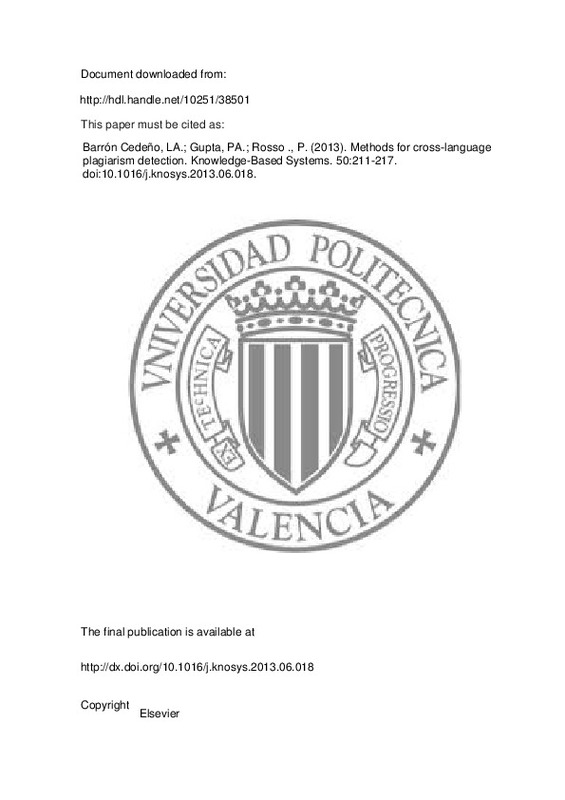JavaScript is disabled for your browser. Some features of this site may not work without it.
Buscar en RiuNet
Listar
Mi cuenta
Estadísticas
Ayuda RiuNet
Admin. UPV
Methods for cross-language plagiarism detection
Mostrar el registro sencillo del ítem
Ficheros en el ítem
| dc.contributor.author | Barrón Cedeño, Luis Alberto
|
es_ES |
| dc.contributor.author | Gupta, Parth Alokkumar
|
es_ES |
| dc.contributor.author | Rosso ., Paolo
|
es_ES |
| dc.date.accessioned | 2014-07-01T17:00:41Z | |
| dc.date.issued | 2013-09 | |
| dc.identifier.issn | 0950-7051 | |
| dc.identifier.uri | http://hdl.handle.net/10251/38501 | |
| dc.description | NOTICE: this is the author's version (pre print) of a work that was accepted for publication in Knowledge-Based Systems. Changes resulting from the publishing process, such as peer review, editing, corrections, structural formatting, and other quality control mechanisms may not be reflected in this document. Changes may have been made to this work since it was submitted for publication. A definitive version was subsequently published in Knowledge-Based Systems. 50:211-217. doi:10.1016/j.knosys.2013.06.018. | es_ES |
| dc.description.abstract | Three reasons make plagiarism across languages to be on the rise: (i) speakers of under-resourced languages often consult documentation in a foreign language, (ii) people immersed in a foreign country can still consult material written in their native language, and (iii) people are often interested in writing in a language different to their native one. Most efforts for automatically detecting cross-language plagiarism depend on a preliminary translation, which is not always available. In this paper we propose a freely available architecture for plagiarism detection across languages covering the entire process: heuristic retrieval, detailed analysis, and post-processing. On top of this architecture we explore the suitability of three cross-language similarity estimation models: Cross-Language Alignment-based Similarity Analysis (CL-ASA), Cross-Language Character n-Grams (CL-CNG), and Translation plus Monolingual Analysis (T + MA); three inherently different models in nature and required resources. The three models are tested extensively under the same conditions on the different plagiarism detection sub-tasks¿something never done before. The experiments show that T + MA produces the best results, closely followed by CL-ASA. Still CL-ASA obtains higher values of precision, an important factor in plagiarism detection when lesser user intervention is desired. | es_ES |
| dc.format.extent | 7 | es_ES |
| dc.language | Inglés | es_ES |
| dc.publisher | Elsevier | es_ES |
| dc.relation.ispartof | Knowledge-Based Systems | es_ES |
| dc.rights | Reserva de todos los derechos | es_ES |
| dc.subject | Automatic plagiarism detection | es_ES |
| dc.subject | Cross-language plagiarism | es_ES |
| dc.subject | Plagiarism detection architecture | es_ES |
| dc.subject | Cross-language similarity | es_ES |
| dc.subject | Text re-use analysis | es_ES |
| dc.subject.classification | LENGUAJES Y SISTEMAS INFORMATICOS | es_ES |
| dc.title | Methods for cross-language plagiarism detection | es_ES |
| dc.type | Artículo | es_ES |
| dc.embargo.lift | 10000-01-01 | |
| dc.embargo.terms | forever | es_ES |
| dc.identifier.doi | 10.1016/j.knosys.2013.06.018 | |
| dc.rights.accessRights | Abierto | es_ES |
| dc.contributor.affiliation | Universitat Politècnica de València. Departamento de Sistemas Informáticos y Computación - Departament de Sistemes Informàtics i Computació | es_ES |
| dc.description.bibliographicCitation | Barrón Cedeño, LA.; Gupta, PA.; Rosso ., P. (2013). Methods for cross-language plagiarism detection. Knowledge-Based Systems. 50:211-217. doi:10.1016/j.knosys.2013.06.018 | es_ES |
| dc.description.accrualMethod | S | es_ES |
| dc.relation.publisherversion | http://dx.doi.org/10.1016/j.knosys.2013.06.018 | es_ES |
| dc.description.upvformatpinicio | 211 | es_ES |
| dc.description.upvformatpfin | 217 | es_ES |
| dc.type.version | info:eu-repo/semantics/publishedVersion | es_ES |
| dc.description.volume | 50 | es_ES |
| dc.relation.senia | 255664 |







![[Cerrado]](/themes/UPV/images/candado.png)

